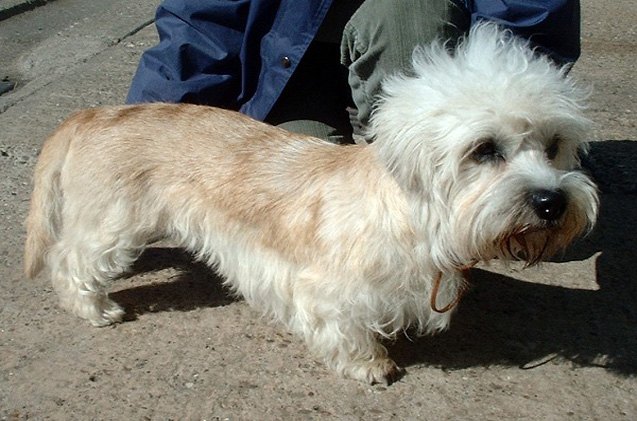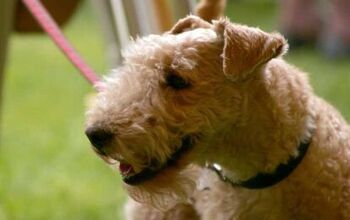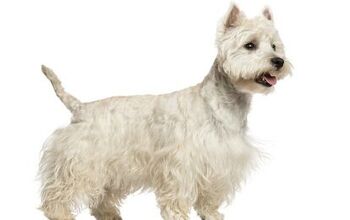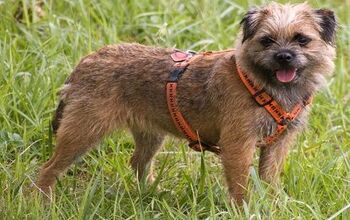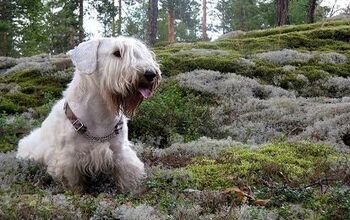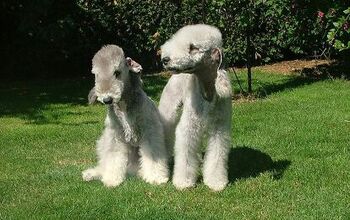Dandie Dinmont Terrier


About Dandie Dinmont Terrier
A dandy little fellow, the Dandie Dinmont Terrier is a distinctive breed, thanks to the poof ball of fur on the top of his head. Calm and reserved, yet full of that famous terrier tenacity, the Dandie is ideal for both urban and country living. Even though you may not see this breed often, the Dandie makes a wonderful companion and terrific watchdog.
Also known as Charlie’s Hope Terrier, the Mustard and Pepper Terrier, the Otter Terrier and the Dandie, this loveable dog is the perfect example of a little dog in a big dog’s body. Even his deep bark seems out of place coming out of such a small dog. Read on to learn more about this interesting breed.
A dandy little fellow, the Dandie Dinmont Terrier is a distinctive breed, thanks to the poof ball of fur on the top of his head.
The Dandie Dinmont Terrier can trace its roots back to the early 1700s, when it was used by hunters and farmers in England and Scotland. This determined terrier would hunt otters and badgers, and “go to ground” to hunt these vermin in their underground dens.
It wasn’t until 1814 when these dogs finally got their name (all of these types of dogs were called terriers). The name is taken from Sir Walter Scott’s book Guy Mannering. Scott owned a number of Dandies and included them in his book. In the book, these dogs were owned by a farmer named Dandie Dinmont and the name stuck, earning them the distinction of being one of the first terriers to be given their own name.
There’s much debate as to the pedigree of the Dandie Dinmont Terrier. Some believe that the breed is a result of Scottish and Skye Terriers, while others think it’s a mix of Dachshund and other hounds. But most experts agree that the Dandie can trace its stock to other breeds such as the Border, Scottish, Cairn, West Highland White, Skye, Lakeland, Bedlington and Welsh Terriers.
Proper feeding of your Dandie is important – if he becomes overweight, it can lead to back problems. You’ll need to monitor his food intake carefully and ensure he gets out for regular exercise. Usually, you can feed your Dandie about 1 to 1.5 cups of high-quality dry food a day, depending on the brand and formula.
The Dandie Dinmont Terrier may be intelligent, but he also has an independent streak, which can make training a challenge.
The Dandie Dinmont Terrier may be intelligent, but he also has an independent streak, which can make training a challenge. Because they think that they can do no wrong, this dog will continue to do what he likes… until told otherwise. You must be assertive and be a leader at all times. Be consistent with your training and never let this little guy get the upper hand. As with most dogs, positive training techniques are most effective, so use praise and treats as rewards for a job well done. Don’t use harsh treatment and discipline when training this terrier (or any other dog), as the Dandie may snap or bite when pushed too hard.
A terrier breed, the Dandie Dinmont Terrier’s weight ranges from 18 to 24 pounds.
The very picture of a big dog in a little dog’s body, the Dandie Dinmont is your typical terrier – bold and fearless. When provoked or tested, the Dandie is up for a scrap. With a deep bark that will alert you to strangers, this breed makes a good watchdog. Once introduced to visitors, the Dandie will be reserved and polite.
You’ll be glad to learn that Dandies aren’t all that yappy, but they are a dog-aggressive breed. That means that if you have a male Dandie Dinmont Terrier, you shouldn’t have another male dog in the household. And because this breed was bred to chase vermin, you shouldn’t have cats or smaller animals in your home as well.
Even though the Dandie Dinmont Terriers is a wonderful family dog, this breed isn’t that good with small children. Toddlers and small children can push this dog outside its strict boundaries and will get bitten if they go too far. They would do better in a household with older children that will know to respect this dog’s boundaries.
The Dandie Dinmont Terrier has a few health concerns you should be aware of. These include intervertebral disc disease, glaucoma, refractory corneal ulceration, hypothyroidism, primary lens luxation, hypochondroplasia and epilepsy. With his long back, you must make sure that your dog doesn’t jump from high places, as this could cause a serious back injury.
The Dandie Dinmont Terrier has an average lifespan of 12 to 15 years.
This little dog needs a moderate amount of exercise to keep him healthy and happy. A daily walk or vigorous play session is all they need. Because of their flexible exercise requirements, a Dandie can live an apartment or condominium, as well as in the suburbs.
The American Kennel Association says this about the breed: “The Dandie Dinmont Terrier is characterized by his long, low body and “scimitar” tail, which looks like a curved sword, as well as his large soulful eyes and fluffy head of hair. Though small in stature, the Dandie has the character of a big dog, possessing confidence, intelligence and an independent nature. The breed’s allowable coat colors are described as “pepper” and “mustard.”” The AKC first recognized this breed in 1886.
The very picture of a big dog in a little dog’s body, the Dandie Dinmont is your typical terrier – bold and fearless.
The most unique feature of the Dandie Dinmont Terrier is the soft topknot perched on the top of his head. The rest of his body is covered with a crisp topcoat and a soft undercoat that is weatherproof. It terms of coat color, Dandies come in shades of mustard and pepper. The mustard shade Dandies range from reddish brown to pale fawn, topped off with a white topknot. Dandies with a pepper-colored coat range from blue-black to light gray, finished off with a silver topknot.
For grooming, you’ll need to brush your Dandie at least once a week to get rid of dead hairs. As well, your Dandie will need to be stripped twice per year (remove dead hair by hand).
Considered to be a rare breed, you may have to do some extensive searching before you find a Dandie puppy. As with most breed, socialize your Dandie Dinmont Terrier as much as possible during the early years, so he can experience new sights and sounds.
Photo credit: Sannse/Wikimedia; Pleple2000/Wikimedia; Bonfirebuddy/Wikimedia

Amy Tokic, Editor of PetGuide.com, is a passionate animal lover and proud pet parent of Oscar, a Shih Tzu/Chihuahua cross, and Zed, a Japanese Chin. Her love of animals began in kindergarten, when she brought her stuffed dog Snoopy into class with her every day. Now, she writes about her adventures in pet ownership and tirelessly researches products, news and health related issues she can share with other animal enthusiasts. In her free time, Amy loves perusing used book and record stores, obsessing over the latest pet products available and chasing squirrels with wild abandon (a habit attributed to spending too much time with her pooches).
More by Amy Tokic



